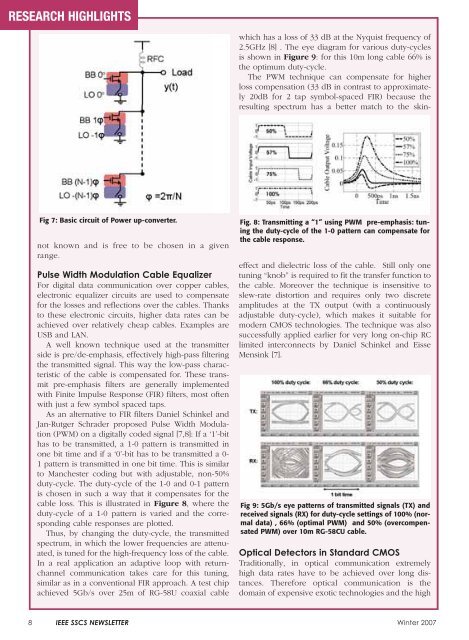The Impact of Dennard's Scaling Theory - IEEE
The Impact of Dennard's Scaling Theory - IEEE
The Impact of Dennard's Scaling Theory - IEEE
- TAGS
- scaling
- www.ieee.org
You also want an ePaper? Increase the reach of your titles
YUMPU automatically turns print PDFs into web optimized ePapers that Google loves.
RESEARCH HIGHLIGHTS<br />
not known and is free to be chosen in a given<br />
range.<br />
Pulse Width Modulation Cable Equalizer<br />
For digital data communication over copper cables,<br />
electronic equalizer circuits are used to compensate<br />
for the losses and reflections over the cables. Thanks<br />
to these electronic circuits, higher data rates can be<br />
achieved over relatively cheap cables. Examples are<br />
USB and LAN.<br />
A well known technique used at the transmitter<br />
side is pre/de-emphasis, effectively high-pass filtering<br />
the transmitted signal. This way the low-pass characteristic<br />
<strong>of</strong> the cable is compensated for. <strong>The</strong>se transmit<br />
pre-emphasis filters are generally implemented<br />
with Finite Impulse Response (FIR) filters, most <strong>of</strong>ten<br />
with just a few symbol spaced taps.<br />
As an alternative to FIR filters Daniel Schinkel and<br />
Jan-Rutger Schrader proposed Pulse Width Modulation<br />
(PWM) on a digitally coded signal [7,8]: If a ‘1’-bit<br />
has to be transmitted, a 1-0 pattern is transmitted in<br />
one bit time and if a ‘0’-bit has to be transmitted a 0-<br />
1 pattern is transmitted in one bit time. This is similar<br />
to Manchester coding but with adjustable, non-50%<br />
duty-cycle. <strong>The</strong> duty-cycle <strong>of</strong> the 1-0 and 0-1 pattern<br />
is chosen in such a way that it compensates for the<br />
cable loss. This is illustrated in Figure 8, where the<br />
duty-cycle <strong>of</strong> a 1-0 pattern is varied and the corresponding<br />
cable responses are plotted.<br />
Thus, by changing the duty-cycle, the transmitted<br />
spectrum, in which the lower frequencies are attenuated,<br />
is tuned for the high-frequency loss <strong>of</strong> the cable.<br />
In a real application an adaptive loop with returnchannel<br />
communication takes care for this tuning,<br />
similar as in a conventional FIR approach. A test chip<br />
achieved 5Gb/s over 25m <strong>of</strong> RG-58U coaxial cable<br />
which has a loss <strong>of</strong> 33 dB at the Nyquist frequency <strong>of</strong><br />
2.5GHz [8] . <strong>The</strong> eye diagram for various duty-cycles<br />
is shown in Figure 9: for this 10m long cable 66% is<br />
the optimum duty-cycle.<br />
<strong>The</strong> PWM technique can compensate for higher<br />
loss compensation (33 dB in contrast to approximately<br />
20dB for 2 tap symbol-spaced FIR) because the<br />
resulting spectrum has a better match to the skin-<br />
Fig 7: Basic circuit <strong>of</strong> Power up-converter. Fig. 8: Transmitting a “1” using PWM pre-emphasis: tuning<br />
the duty-cycle <strong>of</strong> the 1-0 pattern can compensate for<br />
the cable response.<br />
effect and dielectric loss <strong>of</strong> the cable. Still only one<br />
tuning “knob” is required to fit the transfer function to<br />
the cable. Moreover the technique is insensitive to<br />
slew-rate distortion and requires only two discrete<br />
amplitudes at the TX output (with a continuously<br />
adjustable duty-cycle), which makes it suitable for<br />
modern CMOS technologies. <strong>The</strong> technique was also<br />
successfully applied earlier for very long on-chip RC<br />
limited interconnects by Daniel Schinkel and Eisse<br />
Mensink [7].<br />
Fig 9: 5Gb/s eye patterns <strong>of</strong> transmitted signals (TX) and<br />
received signals (RX) for duty-cycle settings <strong>of</strong> 100% (normal<br />
data) , 66% (optimal PWM) and 50% (overcompensated<br />
PWM) over 10m RG-58CU cable.<br />
Optical Detectors in Standard CMOS<br />
Traditionally, in optical communication extremely<br />
high data rates have to be achieved over long distances.<br />
<strong>The</strong>refore optical communication is the<br />
domain <strong>of</strong> expensive exotic technologies and the high<br />
8 <strong>IEEE</strong> SSCS NEWSLETTER Winter 2007




